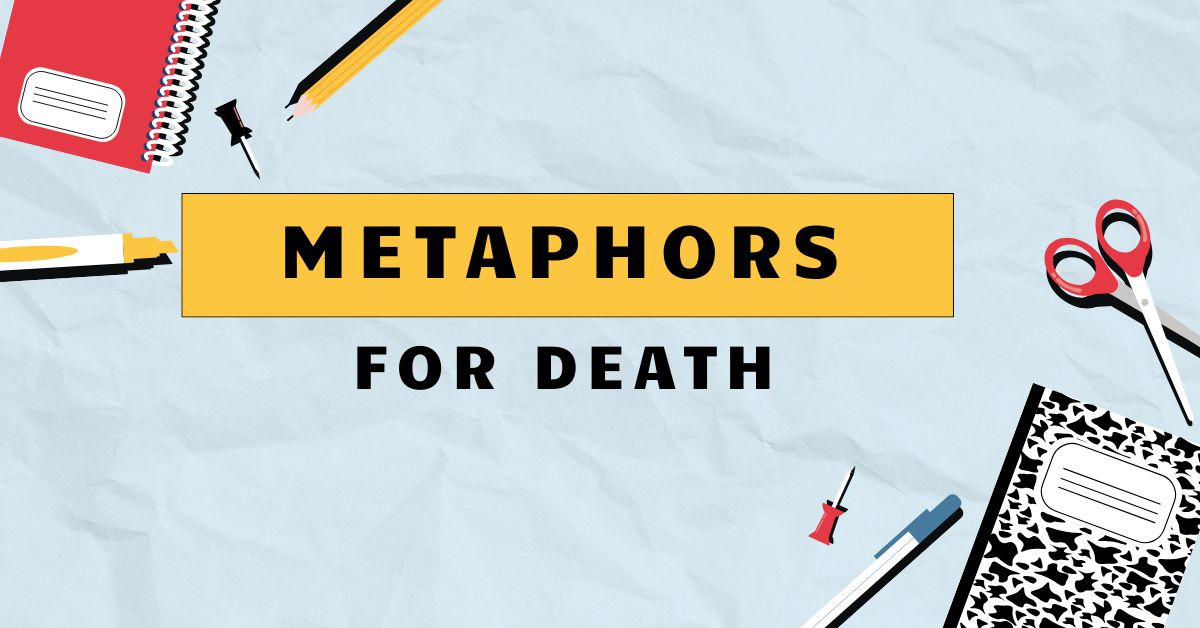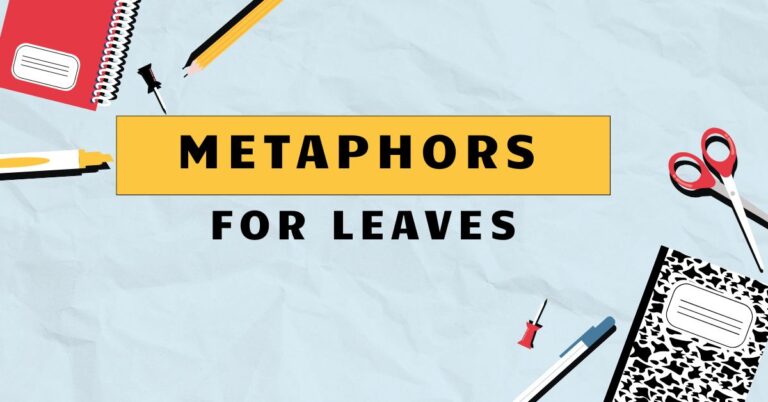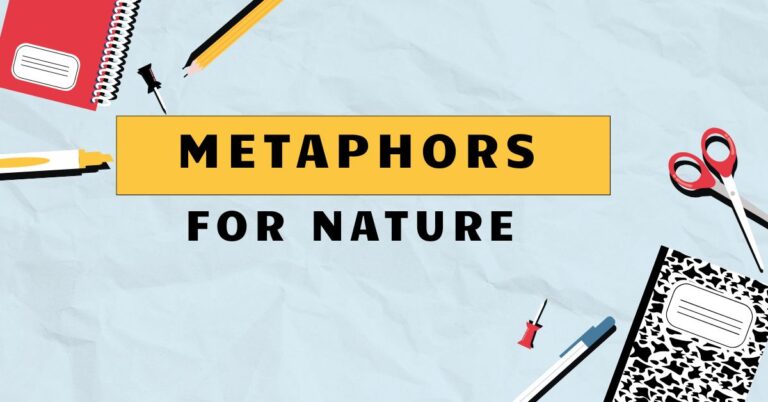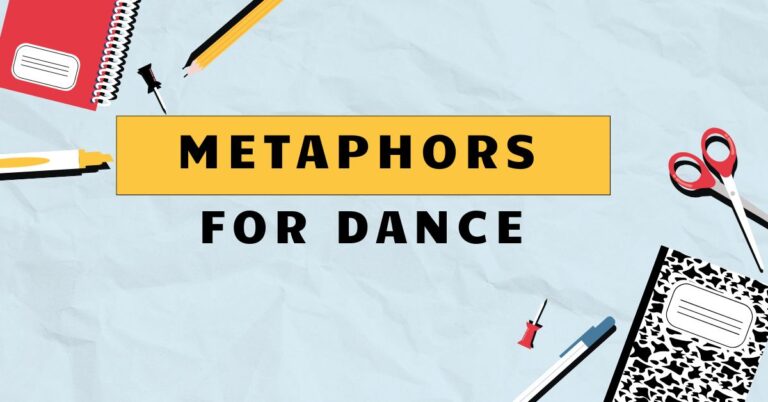47 Metaphors for Death: Understanding Figurative Language
Death, a universal and inevitable aspect of life, is often a difficult subject to discuss directly. Metaphors provide a powerful and nuanced way to explore this complex topic, allowing us to express grief, fear, and acceptance in a more poetic and approachable manner.
Understanding metaphors for death enhances our ability to interpret literature, engage in meaningful conversations, and process our own emotions surrounding mortality. This article will delve into the various types of metaphors used to represent death, providing examples, usage rules, and practice exercises to solidify your understanding.
This guide is perfect for students, writers, and anyone interested in exploring the rich tapestry of figurative language.
By studying these metaphors, you will gain a deeper appreciation for the power of language and its ability to shape our understanding of profound human experiences. Mastering this topic will not only improve your English comprehension and writing skills but also provide you with a more sensitive and insightful perspective on life and death.
Table of Contents
- Definition of Metaphors for Death
- Structural Breakdown of Death Metaphors
- Types and Categories of Death Metaphors
- Examples of Death Metaphors
- Usage Rules for Death Metaphors
- Common Mistakes with Death Metaphors
- Practice Exercises
- Advanced Topics in Death Metaphors
- Frequently Asked Questions
- Conclusion
Definition of Metaphors for Death
A metaphor for death is a figure of speech that describes death by comparing it to something else, without using “like” or “as.” It’s a way to indirectly represent the concept of death, often to soften its impact or to explore its meaning in a more creative and evocative way. Metaphors for death are crucial because they allow us to grapple with a subject that is often taboo or emotionally overwhelming.
They offer a symbolic language to process grief, fear, and acceptance, and they enrich our understanding of mortality through imaginative comparisons.
In essence, a metaphor for death functions by transferring qualities or characteristics from one thing (the source) to death (the target). For example, when we say “Death is a long sleep,” we are transferring the qualities of peace and restfulness associated with sleep to the experience of death.
This helps us to conceptualize death as something less frightening or painful.
Structural Breakdown of Death Metaphors
The structure of a death metaphor typically involves two key elements: thetenorand thevehicle. Thetenoris the subject being described (in this case, death), and thevehicleis the object or concept to which death is being compared.
Understanding this structure helps in analyzing and interpreting the meaning behind different metaphors.
The relationship between the tenor and the vehicle is crucial. The effectiveness of a metaphor lies in the degree to which the similarities between the tenor and the vehicle resonate with the audience.
A strong metaphor will create a vivid and meaningful connection, while a weak metaphor may fall flat or be confusing. The context in which the metaphor is used also plays a significant role in its interpretation.
For instance, consider the metaphor “Death is a thief.” Here, “death” is the tenor, and “thief” is the vehicle. The shared characteristic is the act of taking something away unexpectedly and often without permission.
This metaphor often evokes feelings of anger and injustice.
Types and Categories of Death Metaphors
Death metaphors can be categorized into several types based on the common themes and images they evoke. Understanding these categories can help you recognize and interpret different kinds of death metaphors more effectively.
Personification of Death
Personification involves attributing human qualities or characteristics to death, often portraying it as a figure or entity. This is one of the most common and powerful types of death metaphors.
Examples include: “Death is a grim reaper,” “Death knocked on his door,” or “Death has claimed another victim.” These metaphors often depict death as an active agent, influencing human lives.
Personifying death can make the abstract concept more tangible and relatable. It can also reflect cultural beliefs about the nature of death and its role in human existence.
The image of the Grim Reaper, for example, is a recurring personification of death in Western culture.
Journey Metaphors
Journey metaphors compare death to a voyage or transition from one place to another. These metaphors emphasize the idea of death as a passage or a new beginning.
Examples include: “He embarked on his final journey,” “She crossed the river Styx,” or “They went to a better place.” These metaphors often provide a sense of closure or hope.
Journey metaphors are particularly effective in conveying the idea of death as a natural progression or a transformation. They can also reflect spiritual or religious beliefs about the afterlife.
The concept of crossing a river or entering a new land is a common motif in many cultures.
Sleep and Rest Metaphors
Sleep and rest metaphors equate death with a state of peaceful slumber or eternal rest. These metaphors are often used to soften the harsh reality of death and provide comfort to the bereaved.
Examples include: “He is resting in peace,” “She has gone to her eternal sleep,” or “They are at peace now.” These metaphors emphasize the tranquility and serenity of death.
Sleep and rest metaphors are particularly comforting because they evoke feelings of calmness and relaxation. They can also suggest that death is a natural and necessary part of life, similar to sleep.
This type of metaphor is often used in eulogies and memorial services.
Natural Cycle Metaphors
Natural cycle metaphors compare death to the natural processes of growth, decay, and renewal. These metaphors emphasize the cyclical nature of life and death, suggesting that death is a necessary part of the larger ecosystem.
Examples include: “He returned to the earth,” “She became one with nature,” or “They are part of the circle of life.” These metaphors often provide a sense of continuity and interconnectedness.
Natural cycle metaphors can be particularly meaningful because they remind us that death is not an end but a transformation. They can also foster a sense of acceptance and understanding of the natural world.
This type of metaphor is often used in environmental and spiritual contexts.
End-of-Something Metaphors
End-of-something metaphors describe death as the conclusion of a story, a performance, or a chapter in life. These metaphors emphasize the finality of death and the sense of closure that it brings.
Examples include: “His story came to an end,” “The final curtain fell,” or “The book of her life is closed.” These metaphors often evoke feelings of sadness and reflection.
End-of-something metaphors can be particularly poignant because they highlight the finite nature of human existence. They can also encourage us to appreciate the time we have and to make the most of our lives.
This type of metaphor is often used in biographies and obituaries.
Darkness and Light Metaphors
Darkness and light metaphors use the imagery of darkness or light to represent death, often contrasting life with death. Darkness can symbolize the unknown, fear, or the end of existence, while light can represent hope, peace, or the afterlife.
Examples include: “He passed into the darkness,” “She found the light,” or “They are in the light now.” These metaphors often express contrasting emotions and beliefs.
Darkness and light metaphors are powerful because they tap into universal human experiences and associations. They can also reflect different perspectives on death, ranging from fear and despair to hope and transcendence.
This type of metaphor is often used in religious and philosophical contexts.
Examples of Death Metaphors
The following tables provide a variety of examples of death metaphors, organized by category. Each example is designed to illustrate the different ways in which death can be represented through figurative language.
Understanding these examples will help you recognize and interpret death metaphors in various contexts.
Table 1: Personification of Death Examples
This table showcases how death is personified, given human-like qualities, in various expressions. These metaphors often depict death as an active agent or entity that interacts with the living world.
| Metaphor | Explanation |
|---|---|
| Death is a grim reaper. | Death is depicted as a figure who harvests souls. |
| Death knocked on his door. | Death is portrayed as someone visiting to take a life. |
| Death has claimed another victim. | Death is seen as an entity that takes lives forcefully. |
| Death’s cold hand reached out. | Death is personified with a chilling touch, signaling the end. |
| The angel of death visited him. | Death is seen as a divine messenger bringing the end. |
| Death stood beside her bed. | Death is personified as a looming presence at the end of life. |
| Death whispered his name. | Death is personified as an entity calling someone to the end. |
| Death is a cruel master. | Death is seen as an unforgiving and dominant force. |
| Death is an unwelcome guest. | Death is personified as an unwanted visitor at the end of life. |
| Death is a silent hunter. | Death is personified as a quiet and relentless pursuer. |
| Death is a patient stalker. | Death is seen as an entity that waits for the right moment. |
| Death is a dark shadow. | Death is personified as a looming and ominous presence. |
| Death is a stern judge. | Death is seen as an entity that evaluates a life before ending it. |
| Death is an impartial observer. | Death is personified as a neutral witness to life’s end. |
| Death is a gatekeeper. | Death is seen as an entity guarding the entrance to the afterlife. |
| Death is a ferryman. | Death is personified as a guide across the river to the afterlife. |
| Death is a puppeteer. | Death is seen as a force controlling the end of life. |
| Death is a chess player. | Death is personified as a strategic opponent in life. |
| Death is a gardener. | Death is seen as an entity that prunes and cultivates life. |
| Death is a composer. | Death is personified as a creator of the final movement of life. |
| Death is a weaver. | Death is seen as an entity that creates the tapestry of life and death. |
| Death is a storyteller. | Death is personified as a narrator of the final chapter of life. |
| Death is a dancer. | Death is seen as an entity leading a dance to the end of life. |
| Death is a singer. | Death is personified as a vocalist of the final song of life. |
Table 2: Journey Metaphors for Death Examples
This table illustrates metaphors that compare death to a journey, emphasizing the transition from life to another state or place. These metaphors often provide a sense of closure or hope.
| Metaphor | Explanation |
|---|---|
| He embarked on his final journey. | Death is seen as the ultimate voyage or adventure. |
| She crossed the river Styx. | Death is portrayed as a passage to the underworld. |
| They went to a better place. | Death is seen as a transition to a more peaceful existence. |
| He took his last steps. | Death is metaphorically a final walk or journey. |
| She sailed into the sunset. | Death is seen as a peaceful voyage into the unknown. |
| He ascended to the heavens. | Death is portrayed as a journey to a divine realm. |
| She passed over to the other side. | Death is seen as a transition to another dimension. |
| He reached his final destination. | Death is portrayed as the end of life’s journey. |
| She left this world behind. | Death is seen as a departure from earthly existence. |
| He set sail for eternity. | Death is portrayed as a voyage into endless time. |
| She took her final flight. | Death is seen as a journey into the sky. |
| He walked the final mile. | Death is portrayed as the last part of life’s journey. |
| She entered the gates of paradise. | Death is seen as a passage to a heavenly place. |
| He journeyed to the land of no return. | Death is portrayed as a one-way trip. |
| She traveled beyond the stars. | Death is seen as a voyage into the cosmos. |
| He went on his final pilgrimage. | Death is portrayed as a sacred journey. |
| She crossed the rainbow bridge. | Death is seen as a passage to a magical realm. |
| He embarked on his celestial voyage. | Death is portrayed as a journey through the heavens. |
| She went to her eternal home. | Death is seen as a return to a permanent residence. |
| He set off on his last adventure. | Death is portrayed as the ultimate exploration. |
| She took the stairway to heaven. | Death is seen as a path to a divine place. |
| He boarded the ship to eternity. | Death is portrayed as a voyage on a timeless vessel. |
| She entered the garden of repose. | Death is seen as a passage to a peaceful place. |
| He journeyed to the realm of souls. | Death is portrayed as a trip to a spiritual dimension. |
Table 3: Sleep and Rest Metaphors for Death Examples
This table provides examples of metaphors that compare death to sleep or rest, emphasizing peace and tranquility. These metaphors are often used to comfort those grieving.
| Metaphor | Explanation |
|---|---|
| He is resting in peace. | Death is seen as a state of eternal tranquility. |
| She has gone to her eternal sleep. | Death is portrayed as a long, peaceful slumber. |
| They are at peace now. | Death is seen as a release from suffering. |
| He is sleeping with the angels. | Death is metaphorically a peaceful rest in heaven. |
| She has found her final rest. | Death is seen as a state of ultimate relaxation. |
| He is in a deep slumber. | Death is portrayed as a profound and undisturbed sleep. |
| She has drifted off to eternity. | Death is seen as a gentle transition to endless time. |
| He has closed his eyes forever. | Death is portrayed as a permanent sleep. |
| She has gone to her tranquil repose. | Death is seen as a peaceful and calm state. |
| He is enjoying eternal rest. | Death is portrayed as a continuous state of peace. |
| She has found her peaceful haven. | Death is seen as a safe and quiet place. |
| He is in a state of serene slumber. | Death is portrayed as a calm and untroubled sleep. |
| She has entered her blissful sleep. | Death is seen as a joyful and peaceful state. |
| He is experiencing eternal quietude. | Death is portrayed as a state of endless silence. |
| She has found her ultimate serenity. | Death is seen as a state of complete peace. |
| He is resting in the arms of angels. | Death is portrayed as a peaceful rest in divine care. |
| She has drifted into a dreamless sleep. | Death is seen as a sleep without any troubles. |
| He is in a state of perpetual rest. | Death is portrayed as an unending state of peace. |
| She has found her undisturbed slumber. | Death is seen as a sleep without any interruptions. |
| He is sleeping the sleep of the just. | Death is portrayed as a peaceful rest for the righteous. |
| She has entered her tranquil slumber. | Death is seen as a calm and peaceful sleep. |
| He is in a deep and restful sleep. | Death is portrayed as a profound and peaceful rest. |
| She has found her peaceful eternity. | Death is seen as a calm and endless state. |
| He is sleeping soundly in eternity. | Death is portrayed as a deep and peaceful sleep that lasts forever. |
Table 4: Natural Cycle Metaphors for Death Examples
This table presents metaphors that compare death to natural cycles, emphasizing the continuity and interconnectedness of life and death. These metaphors often provide a sense of acceptance and understanding.
| Metaphor | Explanation |
|---|---|
| He returned to the earth. | Death is seen as a return to the natural world. |
| She became one with nature. | Death is portrayed as merging with the environment. |
| They are part of the circle of life. | Death is seen as a natural and necessary part of the cycle. |
| He turned to dust. | Death is metaphorically a return to the basic elements. |
| She blossomed into the afterlife. | Death is seen as a transition to a new form of life. |
| He returned to the soil. | Death is portrayed as a return to the earth. |
| She became a part of the cosmos. | Death is seen as merging with the universe. |
| He went back to his roots. | Death is portrayed as a return to origins. |
| She transformed into stardust. | Death is seen as becoming part of the celestial realm. |
| He became a seed for new life. | Death is portrayed as a starting point for future growth. |
| She returned to the source. | Death is seen as a return to the origin of life. |
| He became a drop in the ocean. | Death is portrayed as merging with the vastness of existence. |
| She turned into a gentle breeze. | Death is seen as a transformation into a natural element. |
| He became an echo in the wind. | Death is portrayed as a lingering presence in nature. |
| She returned to the great unknown. | Death is seen as a return to the mysteries of the universe. |
| He became a star in the night sky. | Death is portrayed as a shining presence in the cosmos. |
| She returned to the universal energy. | Death is seen as a return to the source of all life. |
| He became a part of the earth’s tapestry. | Death is portrayed as a merging with the environment. |
| She returned to the essence of life. | Death is seen as a return to the core of existence. |
| He became a note in the symphony of life. | Death is portrayed as a part of the harmony of existence. |
| She returned to the cradle of existence. | Death is seen as a return to the origin of life. |
| He became a wave in the ocean of time. | Death is portrayed as a part of the flow of history. |
| She returned to the heart of the world. | Death is seen as a return to the center of existence. |
| He became a whisper in the forest. | Death is portrayed as a subtle presence in nature. |
Table 5: End-of-Something Metaphors for Death Examples
This table provides examples of metaphors that describe death as the conclusion of a story, performance, or chapter in life, emphasizing finality and closure. These metaphors often evoke feelings of sadness and reflection.
| Metaphor | Explanation |
|---|---|
| His story came to an end. | Death is seen as the conclusion of a life narrative. |
| The final curtain fell. | Death is portrayed as the end of a performance. |
| The book of her life is closed. | Death is seen as the completion of a life story. |
| He reached the last page. | Death is metaphorically the end of a written narrative. |
| The song has ended. | Death is seen as the conclusion of a musical performance. |
| The final act is over. | Death is portrayed as the end of a life’s play. |
| The chapter is closed. | Death is seen as the completion of a phase in life. |
| He finished his race. | Death is portrayed as the end of a life’s journey. |
| The game is over. | Death is seen as the conclusion of life’s challenges. |
| His time ran out. | Death is portrayed as the end of allotted lifespan. |
| The last note has been played. | Death is seen as the final moment of a musical piece. |
| The final scene has faded. | Death is portrayed as the end of a visual representation of life. |
| The story is complete. | Death is seen as the culmination of a life’s narrative. |
| The circle is complete. | Death is portrayed as the end of a cycle. |
| The final puzzle piece is in place. | Death is seen as the completion of a life’s design. |
| The last brushstroke is done. | Death is portrayed as the end of a life’s artistic endeavor. |
| The final verse has been written. | Death is seen as the completion of a life’s poem. |
| The last dance has been danced. | Death is portrayed as the end of life’s movements. |
| The last word has been spoken. | Death is seen as the final communication of life. |
| The final page has turned. | Death is portrayed as the end of a life’s narrative. |
| The last memory has faded. | Death is seen as the final moment of remembrance. |
| The last breath has been taken. | Death is portrayed as the final act of life. |
| The final dream has been dreamt. | Death is seen as the end of life’s aspirations. |
| The last star has faded. | Death is portrayed as the end of a celestial light. |
Usage Rules for Death Metaphors
When using metaphors for death, it’s important to consider the context, audience, and desired effect. Here are some key usage rules:
- Be sensitive: Death is a sensitive topic, so choose metaphors that are respectful and appropriate for the situation. Avoid metaphors that are overly graphic or insensitive.
- Consider the audience: Tailor your metaphors to the cultural and emotional background of your audience. What might be comforting to one person could be offensive to another.
- Maintain consistency: If you use a particular metaphor, stick with it throughout your writing or conversation. Mixing metaphors can be confusing and undermine your message.
- Ensure clarity: Make sure your metaphor is clear and easily understood. Avoid metaphors that are too obscure or abstract.
- Use sparingly: While metaphors can be powerful, overuse can diminish their impact. Use them judiciously to highlight key points or evoke specific emotions.
- Avoid clichés: Steer clear of overused metaphors that have lost their impact. Try to find fresh and original ways to express the concept of death.
For example, instead of saying “He kicked the bucket” (a common cliché), you could say “His story came to an end,” which is more sensitive and evocative.
Common Mistakes with Death Metaphors
Here are some common mistakes to avoid when using metaphors for death:
- Mixing metaphors: Combining unrelated metaphors can create confusion and weaken your message.
- Incorrect: “He embarked on his final journey, and the final curtain fell.” (Mixing journey and performance metaphors)
- Correct: “He embarked on his final journey.” (Consistent journey metaphor)
- Using clichés: Overused metaphors can sound trite and insincere.
- Incorrect: “He bit the dust.” (Clichéd metaphor)
- Correct: “He returned to the earth.” (More evocative metaphor)
- Being insensitive: Using metaphors that are disrespectful or offensive can be hurtful to those who are grieving.
- Incorrect: “He’s pushing up daisies.” (Disrespectful metaphor)
- Correct: “He is resting in peace.” (Respectful metaphor)
- Lack of clarity: Using metaphors that are too abstract or obscure can make your message difficult to understand.
- Incorrect: “He transcended into the infinite void.” (Too abstract)
- Correct: “He passed into the darkness.” (Clearer metaphor)
Practice Exercises
Test your understanding of death metaphors with these practice exercises. Identify the type of metaphor used in each sentence and explain its meaning.
Exercise 1: Identifying Metaphor Types
Identify the type of death metaphor used in each sentence.
| Question | Answer |
|---|---|
| 1. Death is a silent thief. | Personification |
| 2. She has gone to a better place. | Journey Metaphor |
| 3. He is sleeping the big sleep. | Sleep/Rest Metaphor |
| 4. She returned to the earth from whence she came. | Natural Cycle Metaphor |
| 5. The final chapter of his life closed. | End-of-Something Metaphor |
| 6. He vanished into the long night. | Darkness/Light Metaphor |
| 7. Death came and took him away. | Personification |
| 8. She embarked on her last voyage. | Journey Metaphor |
| 9. He is now at eternal rest. | Sleep/Rest Metaphor |
| 10. She became one with the universe. | Natural Cycle Metaphor |
Exercise 2: Creating Death Metaphors
Create your own death metaphors for each category.
| Category | Your Metaphor |
|---|---|
| Personification | Example: Death is a gentle guide. |
| Journey Metaphor | Example: He crossed the final frontier. |
| Sleep/Rest Metaphor | Example: She is in a peaceful slumber. |
| Natural Cycle Metaphor | Example: He became nourishment for the soil. |
| End-of-Something Metaphor | Example: The last note of his symphony faded. |
| Darkness/Light Metaphor | Example: She stepped into the light. |
Exercise 3: Correcting Incorrect Metaphors
Correct the following sentences that contain mixed or inappropriate death metaphors.
| Question | Corrected Answer |
|---|---|
| 1. He kicked the bucket and embarked on his final journey. | He embarked on his final journey. |
| 2. She’s pushing up daisies, but she’s in a better place. | She has gone to a better place. |
| 3. Death is a cruel master, and his story ended. | His story came to an end. |
| 4. He’s sleeping with the fishes, and the final curtain fell. | The final curtain fell. |
| 5. She returned to the earth, but she’s in a deep slumber. | She returned to the earth. |
| 6. Death is a silent thief, and he’s pushing up daisies. | Death is a silent thief. |
| 7. He bit the dust and crossed the river Styx. | He crossed the river Styx. |
| 8. She went to a better place, but her story ended. | She has gone to a better place. |
| 9. Death is a grim reaper and sleeping with the fishes. | Death is a grim reaper. |
| 10. He is resting in peace and turned to dust. | He is resting in peace. |
Advanced Topics in Death Metaphors
For advanced learners, consider exploring the cultural and historical context of death metaphors. Different cultures have unique ways of representing death, reflecting their beliefs and values.
For example, some cultures view death as a transition
to an ancestral realm, while others see it as a final end. Studying these diverse perspectives can enrich your understanding of death metaphors and their significance.
Another advanced topic is the use of death metaphors in literature and poetry. Many great writers have used metaphors to explore the themes of mortality, loss, and grief.
Analyzing these works can provide deeper insights into the emotional and philosophical dimensions of death. Consider exploring poems by Emily Dickinson, novels by Leo Tolstoy, or plays by William Shakespeare to see how they employ death metaphors.
Frequently Asked Questions
Conclusion
Metaphors for death are powerful tools that allow us to explore and express our understanding of mortality. By understanding the different types of death metaphors, their structure, and usage rules, you can enhance your ability to interpret literature, engage in meaningful conversations, and process your own emotions surrounding death.
Remember to use these metaphors with sensitivity and clarity, and avoid common mistakes such as mixing metaphors or using clichés. As you continue to explore this topic, you will gain a deeper appreciation for the power of language and its ability to shape our understanding of profound human experiences.







